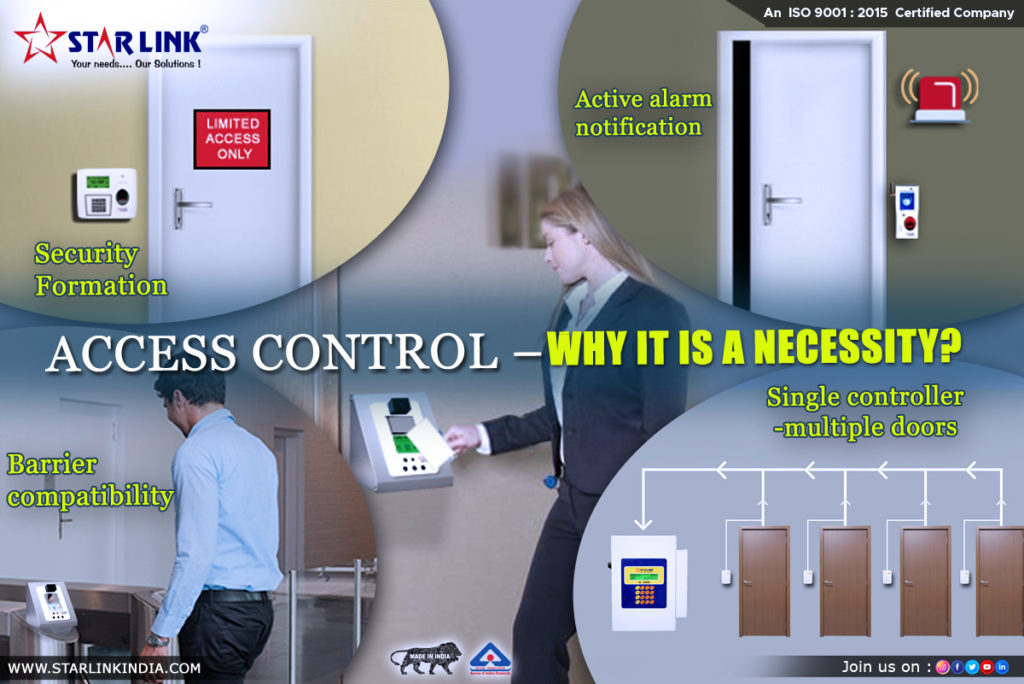24x7x365 Support No. 011-40848888 (Except National Holidays)
24x7x365 Support No. 011-40848888 (Except National Holidays)

Posted On: August 21, 2020
/Categorized In: Access Control System
/Written By: Starlink
Discovering the fact, how a biometric access control system has become a new definition & a key component for office security which can’t be neglected
Let’s start with a simple definition of access control. a system that is used to monitor people’s access in or out from anywhere through technology or man-made measures. With the passage of time, access control went through modifications becoming more centralized and secure. In today’s world Access Control Systems is a digitally secured method to restrict unwanted entrance with the help of fingerprint/smart cards or face reading equipment.
Due to data sensitivity and its protection, all the organizations have forwarded a point of concern over this, and access control systems have started becoming an essential measure for every department, floor, cabins, and unit in the workplace. Not only data protection but all other sorts of unpleasant situations for employees and staff members can be avoided with a digitally secured access control platform.
A biometric access control system allows access only to that person whose biometric data like a fingerprint, face, retina, pupil, or palm is registered in the machine. These machines can also be operated through smart ID cards with unique ID numbers for every employee, pin, password, and combination of all the above features for high-level security. A biometric access control machine alone cannot handle all of this but other accessories with the machine complete the security web like:
A biometric access control system and Biometric Attendance System initiates a security web inside the office which is further divided into departments, sections, stores, rooms, and warehouses. Entry through access control in every section makes sure only limited access is granted and that too only to the authorized personnel which eliminates any threat to security.
In case any attempt to security breach happens, the central alarming system can block all the access control systems at the entry and exit passages creating a lockdown situation and once the investigation will get over, the doors will be released. All of this can happen with Real-Time Data Synchronization with the support of the Internet of Things which will help the security agencies to check the location with minimum time.
This feature enables access permissions which can be restricted through various factors like:
Anti-passback makes sure a single ID card can be used by a single employee to enter or exit any department. The same card passed to any other employee won’t let the door open again whereas feedback lock is a method by which alarm notification gets opened if any restriction is applied to an access control door to let it be open for everyone.
A door controller holds the power to control 4 to 8 doors while recording all the in and out throughout all the doors along with slave readers which read the ID cards for access. This Door Access Control Systems combination simplifies memory storage, storing, and aligning data of particular access areas.
What’s peculiar is identifying the need for the type of access control in your organization by discovering goals and duties to be fulfilled. Here are some points to be considered while opting for it:
1. Outlining the Structure – firstly, we need to design the overall structural chart for the access policies and how they will be followed in the office which will lay the foundation in getting the idea of the system requirements.
2. Levels of Security – Second is the type of equipment you will install in your company which will decide the level of security it will provide. Fingerprint/smart card systems can be the initial one followed by face reading machines and the combination of other options like a pin with a password, face with a password, and many others.
3. System configurations – while some access control can be window-based and some can be web-based which will demand different configuration, capacity, system, and network upgrades which will plan the additional costs.
Read more: How to Configure Wi-fi in Bio-Facer Reader?
4. Business Expansion – this point should be kept under consideration if your organization will plan for expansion in the future which will give rise to access control upgrades. One should opt for such systems which will provide after-sales services and should be an indigenous manufacturer.
Read More: How Does A Time & Attendance System Add Value To Your Business?
Checkout our other products:
